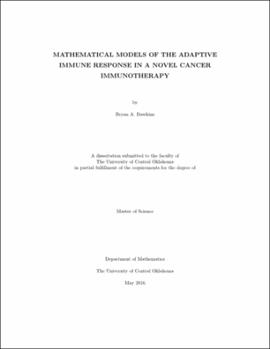| dc.contributor.advisor | Laverty, Sean | |
| dc.contributor.author | Dawkins, Bryan A. | |
| dc.date.accessioned | 2020-07-09T14:39:18Z | |
| dc.date.available | 2020-07-09T14:39:18Z | |
| dc.date.issued | 2016 | |
| dc.identifier.other | (AlmaMMSId)9982462183402196 | |
| dc.identifier.uri | https://hdl.handle.net/11244/325032 | |
| dc.description.abstract | The immune system is the first line of defense against cancer. The immune system regularly detects and destroys cancer cells. Despite this continuous protection, certain cancers are able to escape detection or destruction by the immune system. Research in recent decades has addressed the possibility of enlisting the help of the immune system to detect and destroy cancer cells. One compelling treatment uses a laser, an immune stimulant called glycated chitosan (GC), and a light absorbing dye called indocyanine green to convince the immune system to incite a systemic attack against both primary and metastatic tumors. In successful treatments, all tumors are completely destroyed and patients develop long-term immunity against tumors. While attempting to locate and destroy tumor cells, the cells of the immune system face competing pressures. On one hand are the immune cells that detect and attempt to control tumor cells (typically the target of the immune response is a foreign invader), and on the other hand are the immune cells that prevent the response from growing dangerously out of control. By policing certain immune cell populations, regulatory T cells (Tregs) play an important role in keeping the overall immune response under control. But, in doing so, these Tregs indirectly protect cancer cells. We describe post-treatment immune dynamics with mathematical models, and predictions of clinical treatment outcomes can be drawn from model predictions. Currently we emphasize the role of cytotoxic T cells and dendritic cells in the laser-initiated immune response, but we have also studied the roles of B cells and helper T cells. Our model is based on experimental studies with the dimethylbenza(a)nthracene-4 (DMBA-4) metastatic mammary tumor line in the rat animal model. We have used our model to determine clinical outcomes based on the effects of two key treatment factors: the dose and role of GC, and the manipulation of Treg activity. Treatment outcome is improved by the pro-immune stimulatory properties of GC and worsened by the proposed pro-tumor activity of Tregs. The results from our studies indicate potential treatment designs that could be used to improve treatment outcome or highlight additional areas that should be targeted for future experimentation with animal models. | |
| dc.rights | All rights reserved by the author, who has granted UCO Chambers Library the non-exclusive right to share this material in its online repositories. Contact UCO Chambers Library's Digital Initiatives Working Group at diwg@uco.edu for the permission policy on the use, reproduction or distribution of this material. | |
| dc.subject.lcsh | Cancer | |
| dc.title | Mathematical models of the adaptive immune response in a novel cancer immunotherapy. | |
| dc.type | Academic theses | |
| dc.contributor.committeeMember | Bannish, Brittany E. | |
| dc.contributor.committeeMember | Chen, Wei | |
| dc.contributor.committeeMember | Morris, Tracy L. | |
| dc.thesis.degree | M.S., Mathematics | |
| dc.subject.keywords | Applied mathematics | |
| dc.subject.keywords | Biology | |
| dc.subject.keywords | Antitumor laser immunotherapy | |
| dc.subject.keywords | Immunology | |
| dc.subject.keywords | Mathematical models | |
| dc.identifier.oclc | (OCoLC)ocn956513257 | |
| uco.group | UCO - Graduate Works and Theses::UCO - Theses | |
| thesis.degree.grantor | Jackson College of Graduate Studies. | |
